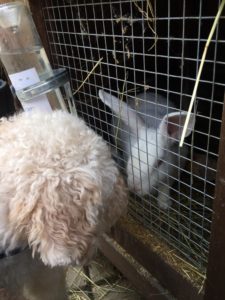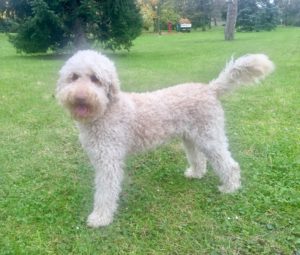Standard Australian Labradoodle
The Australian Labradoodle was originally bred around 30 years ago to provide allergy and asthma friendly service dogs. Their popularity has rapidly increased and they can now be found not only in service, but in homes around the world as very much loved family companions. They make wonderful pets, primarily because they are incredibly sociable and love to be with their people. They are very intelligent and well balanced dogs. Calm, gentle and loving, but full of fun!
The Australian Labradoodle has six parent breeds: Labrador, Poodle, English Cocker Spaniel, American Cocker Spaniel, Irish Water Spaniel and Curly Coat Retriever. These breeds were carefully infused over many generations of breeding to produce the fantastic dogs that we now refer to as multi-generation Australian Labradoodles.
Mouth: Must be a scissor bite. Upper teeth to just overlap the bottom teeth. Nose: Should be large, of square appearance and fleshy. Neck: Well proportioned of good strength, moderately long lending an air of elegance, slightly arched and flow into shoulders with no appearance of abruptness. Forequarters: Shoulders blades and upperarms to be the same length, and shoulders should be well laid back. Elbows are set close to the body. Forelegs to be straight when viewed from the front. Toeing in our out is a fault. Body: Height (to wither) as to length (from sternum to point of buttock) should appear square and compact. Deep chest and well sprung. There should be a good tuck up. Loins should be strong and muscular. Hindquarters: In profile the croup is nearly flat, slight sloping of the croup is acceptable. Stifles should be moderately turned to propel forward movement, and hindquarters well muscled for power in movement. Hock to heel should be strong and short being perpendicular to the ground. View from the rear should be parallel to each other, must not be cow-hocked. Feet: The feet are of medium size, round with well-arched toes having elastic and thick pads. The feet should not turn in or out. Tail: The tail should follow the topline in repose or when in motion. It may be carried gaily, but should not curl completely over the back. Tip of tail should not touch the back nor curl upon itself. Movement: Trotting gait is effortless, smooth, powerful and coordinated in mature dogs. Should have a good reach in front and drive from behind for forward motion. Sound free movement and a light gait are essential.
 Extremely clever, sociable, comical, joyful, energetic when free and soft and quiet when handled. They should approach people in a happy friendly manner, keen and easy to train. They should display an intuition about their family members or handler’s current emotional state or needs. This ability to “know” is what has made the Australian Labradoodle an excellent dog for individuals with special needs and makes them particularly good with children, elderly and handicapped people. Social with other dogs and pets and very loving towards their families. Australian labradoodle averages is 15 years.
Extremely clever, sociable, comical, joyful, energetic when free and soft and quiet when handled. They should approach people in a happy friendly manner, keen and easy to train. They should display an intuition about their family members or handler’s current emotional state or needs. This ability to “know” is what has made the Australian Labradoodle an excellent dog for individuals with special needs and makes them particularly good with children, elderly and handicapped people. Social with other dogs and pets and very loving towards their families. Australian labradoodle averages is 15 years.
